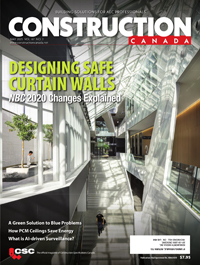Hubbards, N.S., is now home to Rockbound, a 381 m2 (4,100 sf) residence designed by Omar Gandhi Architects (OGA). Facing the Atlantic coastline, the three-bedroom house was developed as a coastal retreat with an...
Tag: Cladding
StudioAC has introduced Everden, its new single-family residence. The aim was to create a contemporary home, unique and personal to the homeowners, while still having cues to the traditional ideas of “house”. What followed...
One of the latest campus buildings, the Calvin and Tina Tyler Hall Student Services Center at Morgan State University (MSU) in Baltimore, Maryland, epitomizes the synthesis of neoclassical and modern architecture with Canadian Eramosa...
By Dale Payne, P.E. With a lack of available space, developing the rooftop, or “fifth facade,” has become an essential solution. Facility managers and specifiers tasked with building and renovating office buildings, schools, and...
Achieving net-zero goals with architectural zinc
(07/14/2023)
For roofing and wall cladding products, architectural zinc’s inherent metallic properties can help reduce the operational carbon footprint for residential and commercial buildings, and improve their energy-efficient, climate-resilient, long-lasting performance.
Tension fabric structures have served a key role as a cost-effective facility solution for years. In some cases, users have turned to fabric buildings when brick-and-mortar construction is not economically feasible or would take...
Recently, ironworkers placed the final curved steel beam 47 storeys above downtown Toronto, crowning Cadillac Fairview’s 160 Front Street West commercial office tower, a short walk away from the CN Tower.
Rejuvenating old masonry facades with overcladding
(04/03/2023)
Investing in smart, context-sensitive overcladdings—as well as upgrading older masonry buildings with new, energy-wise envelope improvements—can contribute to not just better buildings but also improved neighbourhoods.
Designing with foam plastic insulating sheathing
(01/23/2023)
When modified and/or accessorized properly, the same insulation board providing thermal resistance may serve as an air, weather, and/or vapour barrier. Select foam plastic insulating sheathing (FPIS) products merge all barriers and the wall...
Combining multiple esthetics is the standard rather than the exception in building exteriors. And since the days of monolithic design are long gone, architects are pushing the limits by integrating materials to create a...

